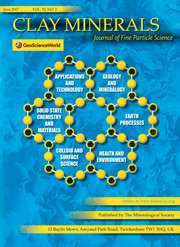Article contents
Separation of long-chain and compact molecules by adsorption to attapulgite-containing clays
Published online by Cambridge University Press: 14 March 2018
Extract
For several decades clays have been used for decolorising mineral oils. A simple method is percolation of the oil through a layer of clay. Some twenty times the amount of oil is usually treated with such a layer. The first oil filtered through the fresh clay is much more changed than the rest of the oil. It has a very light colour and its low refractive index indicates a high content of paraffinic and naphthenic hydrocarbons.
Most of the aromatic hydrocarbons are left behind in the clay. This suggests adsorption analysis of oils using clay in the same large quantities that have been successful with other adsorbents (Mair and White, 1935; Willingham, 1939; Allibone, 1941). Quantities of the order of 100 gm. alumina per gm. hydrocarbon were used by Winterstein and associates (1934) when separating a number of aromatic hydrocarbons.
- Type
- Research Article
- Information
- Copyright
- Copyright © The Mineralogical Society of Great Britain and Ireland 1949
- 5
- Cited by


